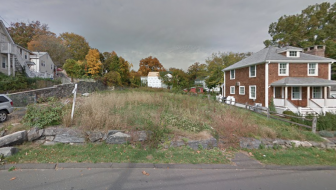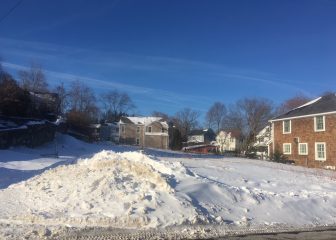The owner of a vacant, narrow lot on the edge of downtown New Canaan is seeking permission to build a two-family home on the .27-acre property.

102 Locust Ave., New Canaan. Google Streetview
The town 15 years ago issued a demolition permit for the house that had stood at 102 Locust Ave. In May 2013, the town issued its then-owner a permit to build a new 4,000-square-foot single-family home there, but the owner never came in to pay for it, building records show. The next month, a limited liability company whose principals live in Rye, N.Y. bought the vacant lot for $520,000.
That company—Imperial Real Estate Holdings LLC—has filed an application for a variance in order to build what appears to be a single two-family dwelling running the length of the lot, near the intersection of Locust at Hillside Avenue.

A look at the lot at 102 Locust Ave. on Jan. 7, 2017. Credit: Michael Dinan
According to a statement that forms part of an application to the Zoning Board of Appeals—it’s available here in the dropdown—“the property is located in the Business Residential Zone of New Canaan and is zoned for multi-family residential purposes.”
“After reviewing alternative uses for this property, we have determined that the only viable current option for its development would be to build a two-family residential home on the property. However, we have been advised by the Planning and Zoning Department that the property is non-conforming because its frontage is less than the required 100 feet for this type of development. The property has frontage of 75 feet. We are respectfully requesting that the Board approve a variance of 25 feet in frontage to allow a two-family residence to be constructed on the property.”
The letter is attributed to the LLC’s managing director (not a land use attorney).
In fact, the property is in the B Residential zone, and under the New Canaan Zoning Regulations—see section 3.2.C.a.1 on page 42 here—P&Z may issue a special permit for a two-family dwelling in that zone provided that: the building has side yards of at least 15 feet; required parking spaces are provided behind the front lot line; and the lot has continuously been used for a two family structure since before July 25, 1969, or the lot contains at least 12,000 square feet, has a lot width upon a public street of at least 100 feet and contains a lot circle diameter of at least 100 feet.
The applicant refers only to a section of the zoning regulations that sets forth minimum width for front lots. Yet for the B Residence Zone, the minimum width is 75 feet in any case.
In the application, the LLC managing director asserts: “We believe your granting the variance would be beneficial to the town since it would remove a parcel of vacant land from the center of town and replace it with attractive residences for two families who would be able to easily walk to town to make use of its shops and restaurants.”
The application appears to be listed for the ZBA’s Feb. 5 meeting.

102 Locust is in the B residence zone. Not the business zone.
You are correct, Peggy, and we did note that in the story. As some readers have been discussing in a comment thread on our Facebook page, there appears to have been no land use attorney hired to put together this application. It seems to me that the property owner must come to P&Z for a special permit rather than the ZBA for a variance. While some straightforward applications made directly by property owners without the help of a land use lawyer have gone through these governing bodies in the past, it’s good practice to consult with an attorney who knows the regulations. The last major application that came before P&Z where a lawyer wasn’t hired by the applicant was the redevelopment proposal for the Roger Sherman Inn, and that was denied. I will also say that the ZBA has taken a very dim view of applications where a property owner wants to create a two-family dwelling where a single-family home had existed. The board prefers to meet its charge by granting variances for hardships such as when a structure predates the zoning regulations or for problems that run with the land—for example, unusual topography, corner lot with two front yards (for setback issues) or lots of wetlands on a parcel.
As the two houses to the East of #102 have been preserved and converted back to single family use, it would appear to me that this new house should be single family also, with the same setback as the other houses near-by.